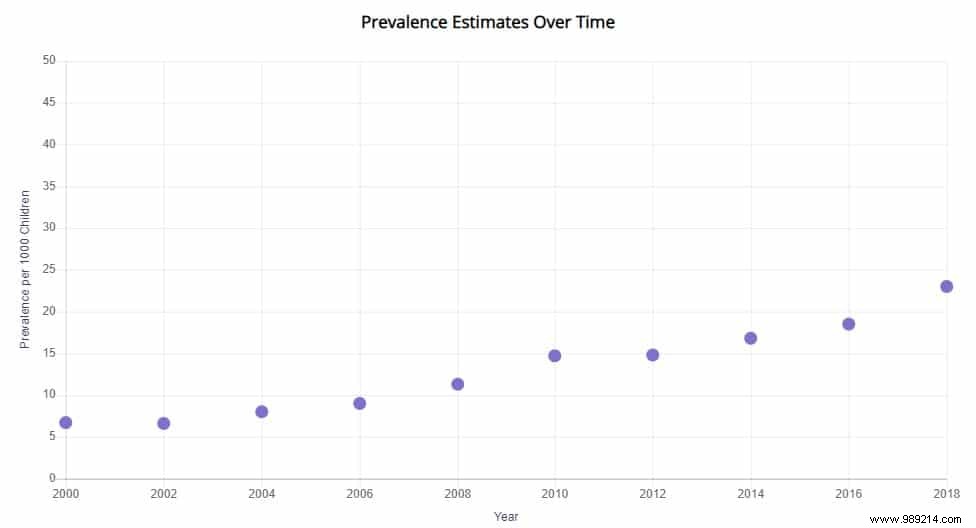April 2 was World Autism Awareness Day, also known as Autism Spectrum Disorder (ASD). The opportunity to learn more about what concerns more and more people around the world:about one in 160 today. If genetics remains a preponderant factor, how can the increase in the prevalence of disorders be explained? By a better diagnosis, of course, but also by a contaminating environment.
Autism is a neurodevelopmental disorder that primarily affects social interactions and communication throughout the life of the person concerned. As the diversity of the disorders is important and very variable from one individual to another, we rather speak of "autism spectrum disorders".
They are manifested by difficulties in establishing social interactions and communication, and by different motor skills. Criteria outlined in the DSM-5 (Diagnostic and Statistical Manual of Mental Disorders) include persistent deficits in social interactions and emotional reciprocity, lack of interest in friends, repetitive or inappropriate behaviors, reluctance to change , particular sensory reactions (auditory, visual, etc.). You should know that ASD is not systematically associated with intellectual retardation.
Today, approximately one in 160 people in the world have an autism spectrum disorder. According to INSERM, around 700,000 people are affected in France, 100,000 of whom are under 20 years old. But the prevalence of autism has been steadily increasing in recent years. A study reported by the United States Centers for Disease Control and Prevention (CDC) (a major federal public health agency) indicates that one in 44 8-year-old children had an ASD diagnosis in 2018, compared to one in 250 children in 2001!

While the causes of autism are not yet clear, an interaction between genetic and environmental factors could explain it. Generally appearing before the age of 3, ASD appears very early in brain development (at the prenatal stage). With the development of DNA sequencing techniques, researchers have been able to identify a large number of genes involved in autism, to discover more than 800 in total!
“Heredity and more broadly genes remain the preponderant factor, explaining at least 60% of autism », written for The Conversation Franck Ramus, CNRS research director and associate professor. “Researchers speak of ‘heritability’, thus designating the part of the disorder linked to genetics. A heritability of 50%, for example, means that genetic predispositions will play 50% in the autism of an individual, other factors related to the environment in which he evolves coming to complete this trigger-9999999999999eur ". It is certain that genetics alone cannot explain the increase in cases of ASD, because the human genetic heritage cannot change so quickly.
“It is no longer possible to deny the effect of the environment on autistic disorders », entrusts to Time biologist Barbara Demeneix. According to her, a large number of studies show a strong link between the exposure of pregnant women to substances such as endocrine disruptors (molecules from industrial chemistry capable of interacting with the hormonal system, such as certain pesticides) and a high risk of having a child with autism spectrum disorder, hyperactivity or attention deficit disorder.
For example, a study conducted in California between 1997 and 2008 among 486 children with ASD and 316 unaffected children highlighted this link (without however proving a causal link). California is a state where it is required by law to record the precise location of every commercial application of pesticides to agricultural lands and other sites. The researchers thus assessed the distance between the family residence and the areas where pesticides were applied during pregnancy. Finally, the risk of ASD was doubled for children born to women living near an area where organophosphate pesticides were sprayed during their third trimester of pregnancy. Scientists have also found a strong correlation between the application of pyrethroid pesticides and the risk of ASD.
In 2016, researchers exposed enriched cultures of mouse cortical neurons to hundreds of chemicals commonly found in the environment and in food. Result:rotenone (a pesticide associated with the risk of Parkinson's disease) and fungicides modified the expression of genes associated with autism. Bisphenol A — a plasticizer present in bottles, food packaging, etc., and banned in France since 2015 — has also been recognized as a risk factor.
But that's not all:air pollution would also present its share of responsibility. A 2014 study showed that pregnant women exposed to fine particle pollution during their third month of pregnancy had a higher risk of having a child with ASD. Indeed, sulfur oxides and particles released by industries remain major sources of pollution. The particles can be as small as 10 micrometers in size, but "even exposure to very small amounts of fine particles has been linked to premature births, delayed learning, and a range of serious health problems “, reports Yuming Guo, lead author of a more recent study on the subject. Indeed, the results show that children exposed to particles of 1 micrometer during the first three years of their life have an 86% additional risk of developing an ASD.
During pregnancy, it is therefore essential to protect pregnant women as much as possible from endocrine disruptors, pesticides and air pollution. In addition, taking certain medications would increase the risk of having a child with ASD, such as paracetamol:prenatal exposure would lead to an average 20% higher risk.
Moreover, it cannot be denied that part of the increase in the prevalence of ASD is directly attributable to the fact that there are more criteria for making the diagnosis on the autism spectrum (instead of strict autism). and that overall, parents and practitioners are more vigilant. Today, this diagnosis is therefore made more frequently and at a younger age than in the past. On the other hand, parents have children later in life, which appears to be a documented risk factor for ASD.
However, these causes cannot completely explain the increase in the prevalence of ASD, which seems largely attributable to the influence of the environment on pregnant women and young children. Numerous studies report in particular the neurotoxicity of endocrine disruptors and pollution, which are very present in our environment.